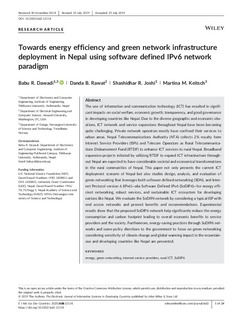| dc.contributor.author | Dawadi, Babu Ram | |
| dc.contributor.author | Keitsch, Martina | |
| dc.contributor.author | Rawat, Danda B. | |
| dc.contributor.author | Joshi, Shashidhar R. | |
| dc.date.accessioned | 2020-01-30T09:55:26Z | |
| dc.date.available | 2020-01-30T09:55:26Z | |
| dc.date.created | 2020-01-19T09:55:17Z | |
| dc.date.issued | 2019 | |
| dc.identifier.issn | 1681-4835 | |
| dc.identifier.uri | http://hdl.handle.net/11250/2638818 | |
| dc.description.abstract | The use of information and communication technology (ICT) has resulted in significant impacts on social welfare, economic growth, transparency, and good governance in developing countries like Nepal. Due to the diverse geographic and economic situations, ICT network and service expansions throughout Nepal have been becoming quite challenging. Private network operators mostly have confined their services to urban areas. Nepal Telecommunications Authority (NTA) collects 2% royalty form Internet Service Providers (ISPs) and Telecom Operators as Rural Telecommunications Disbursement Fund (RTDF) to enhance ICT services to rural Nepal. Broadband expansion projects initiated by utilizing RTDF to expand ICT infrastructure throughout Nepal are expected to have considerable societal and economical transformations in the rural communities of Nepal. This paper not only presents the current ICT deployment scenario of Nepal but also studies design, analysis, and evaluation of green networking that leverages both software defined networking (SDN), and Internet Protocol version 6 (IPv6)—aka Software Defined IPv6 (SoDIP6)—for energy efficient networking, robust services, and sustainable ICT ecosystem for developing nations like Nepal. We evaluate the SoDIP6 network by considering a typical ISP with end access networks and present benefits and recommendations. Experimental results show that the proposed SoDIP6 network help significantly reduce the energy consumption and carbon footprint leading to overall economic benefits to service providers and the society. Furthermore, energy‐saving practices through SoDIP6 networks and some policy directions to the government to focus on green networking considering sensitivity of climate change and global warming impact in the mountainous and developing countries like Nepal are presented. | nb_NO |
| dc.language.iso | eng | nb_NO |
| dc.publisher | Wiley | nb_NO |
| dc.rights | Navngivelse 4.0 Internasjonal | * |
| dc.rights.uri | http://creativecommons.org/licenses/by/4.0/deed.no | * |
| dc.title | Towards energy efficiency and green network infrastructure deployment in Nepal using software defined IPv6 network paradigm | nb_NO |
| dc.type | Journal article | nb_NO |
| dc.type | Peer reviewed | nb_NO |
| dc.description.version | publishedVersion | nb_NO |
| dc.source.volume | 86 | nb_NO |
| dc.source.journal | Electronic Journal of Information Systems in Developing Countries | nb_NO |
| dc.source.issue | 1 | nb_NO |
| dc.identifier.doi | https://doi.org/10.1002/isd2.12114 | |
| dc.identifier.cristin | 1776637 | |
| dc.description.localcode | © 2019 The Authors. The Electronic Journal of Information Systems in Developing Countries published by John Wiley & Sons Ltd This is an open access article under the terms of the Creative Commons Attribution License, which permits use, distribution and reproduction in any medium, provided the original work is properly cited. | nb_NO |
| cristin.unitcode | 194,61,45,0 | |
| cristin.unitname | Institutt for design | |
| cristin.ispublished | true | |
| cristin.fulltext | postprint | |
| cristin.qualitycode | 1 | |

